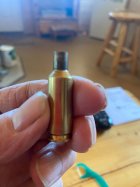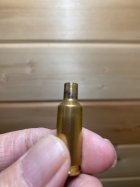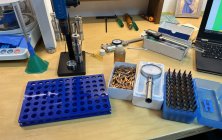I don't really know what to say to you at this point.
It's been explained fairly well in my opinion. I've used the shoulder method for several years and used it in competition with a fair amount of success.
I can honestly look back and see where this method brought an incredible increase in seating consistency and my match results noticably improved at the same time.
Yet you as a person who clearly has never tried it and doesn't understand it continues to tell people they are wrong and your way is better.
im just going to say I disagree with everything you say above in this post because I have used both methods being discussed and can speak from experience.
The shoulder is more of a constant than the entire case concerning the touch point/ogive
The distance between the ogive and shoulder is much shorter than the case base to ogive, that alone makes it more consistent and eliminates any inconsistencies between the shoulder and the base.
I looked at the Accuracy one tool and even watched a video of its use
I get it, and its a nice tool and another way of skinning the cat - A viable method
---
Allow me to explain a little further since Im not Knocking it its just that the OP asked of there is
"An Alternative to it"
So I listed an alternative, and a cheaper one at that
---
As well myself, being a machinist and having all sorts of measuring tools including depth measuring
If I wanted another method of doing this, I would just use one of my various tools
I will show a picture of something I went and looked in my tool drawer and thought I could whip together the same thing in effect in about 5 minutes
---
I am more the type who doesnt buy things I see to be needless
other people Love buying new gadgets
And thats fine,
---
However, My main contention is when measuring or checking on the Ogive of the bullet
the only real accurate place to index off from is where the ogive touches the lands
The Sinclair nut Does this.
If a tool is indexing from any other point further up the bullet to the tip there will be variations
IE: When measuring base to ogive on bullets such as 6mm it is proper to use the 6mm hole on the comparator for example using
"the correct hole dia. for the bullet being loaded"
---
Now if I use a .22 hole to measure on a 6mm bullet, the ogive up further is not as consistent due to how the bullets ogive curve is formed
and I would get larger variations the further up toward the tip I index from.
Similar to how we can also have bullets with consistent base to ogive, but inconsistent OAL.
So unless the tool is indexing in the .237" range for a 6mm bullet...
I dont see how consistency can be improved when further up the ogive toward the tip has shown to have larger differences as we go up the tip.
If we measure where the bullet is reducing down in diameter from where the Ogive actually meets the rifling, I would see larger difference in the indicator reading.
I First noticed this type of variation with a seating die stem being small in diameter in the hole that the bullet tip fits into, Yet when I measured base to Ogive on the bullet, they all measured the same
How can there be a difference then in seating depth?
I enlarged the stem hole dia, and seating depth consistency came back.
---
there is a reason say with the Sinclair nut, we would not want to use the 22 hole for 6mm bullets
even though we could index at that reduced dia. on the bullet and get some kind of readings.
---
I do not see where the Accuracy One tool has inserts for different bullet diameters
(Perhaps I missed this?) to be able to index from and measure in the proper place on the ogive,
IE: the dia. where the lands would be touching the bullet.
---
So real quick instead of spending $150 bucks I just went into my machinist box and whipped this up and tried it out
I do see the speed of using such a tool
----------------------------------------
However again,
I do not see the importance of checking Seating Depth for
every single cartridge
meaning if we did check every single case we loaded , sure, I think Id switch over to that tool
But What I see in my loading room with my tools and dies is
Once I get my seating die adjusted to the seating depth I want
It does not change
Meaning there is no reason to keep checking seating depths for every single round being loaded
Once set, we can now load 100 rounds without checking again
So when I use the Sinclair nut, I maybe only check the first 3 rounds for consistency, then go to loading the rest, then will check the last one for insurance nothing changed.
So that's 4 times used for 100 rounds loaded. Does a guy really need to speed that up ?
If so, fine. use the different tool.
-----------------------------------------
ALSO and this very important to consider
I DO USE - a concentricity gauge for every loaded round
If the seasting depth were off at all, the concentricity gauge would read a different number than it should
If the ogive is different in curve, the concentricity gauge shows a different number
When all loaded rounds are at the same seating depth
the concentricity gauge itself reveals the same number on the indicator
So again, Once I load my first few rounds and check initial seting depth
---Seating depth tools are not touched again for that loading session negating the need to check every single loaded round since it is the concentircity gauge which allows redunduncy of double checking.
---
A TDC Depth Indicator can be used as the same tool and index off the shoulder
but I believe the hole the bullet fits into on the gauge should be the approriate dia for the ogive and dia of bullet used for the best measurement of consistency.
All I would have to do for that on the TDC checker is whip up an insert for different bullets
---
Does the Accuracy One tool, have different inserts for different Dia. Bullets? to ensure proper consistency?
















